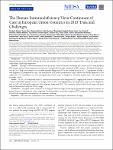The Human Immunodeficiency Virus Continuum of Care in European Union Countries in 2013: Data and Challenges
Gourlay, Annabelle
Noori, Teymur
Pharris, Anastasia
Axelsson, Maria
Costagliola, Dominique
Cowan, Susan
Croxford, Sara
Monforte, Antonella d’Arminio
Amo, Julia del
Delpech, Valerie
Díaz, Asunción
Girardi, Enrico
Gunsenheimer-Bartmeyer, Barbara
Hernando, Victoria
Jose, Sophie
Leierer, Gisela
Nikolopoulos, Georgios
Obel, Niels
Coul, Eline Op de
Paraskeva, Dimitra
Reiss, Peter
Sabin, Caroline
Sasse, André
Schmid, Daniela
Sonnerborg, Anders
Background: The Joint United Nations Programme on HIV/AIDS (UNAIDS) has set a "90-90-90" target to curb the human immunodeficiency virus (HIV) epidemic by 2020, but methods used to assess whether countries have reached this target are not standardized, hindering comparisons. Methods: Through a collaboration formed by the European Centre for Disease Prevention and Control (ECDC) with European HIV cohorts and surveillance agencies, we constructed a standardized, 4-stage continuum of HIV care for 11 European Union countries for 2013. Stages were defined as (1) number of people living with HIV in the country by end of 2013; (2) proportion of stage 1 ever diagnosed; (3) proportion of stage 2 that ever initiated ART; and (4) proportion of stage 3 who became virally suppressed (≤200 copies/mL). Case surveillance data were used primarily to derive stages 1 (using back-calculation models) and 2, and cohort data for stages 3 and 4. Results: In 2013, 674500 people in the 11 countries were estimated to be living with HIV, ranging from 5500 to 153400 in each country. Overall HIV prevalence was 0.22% (range, 0.09%-0.36%). Overall proportions of each previous stage were 84% diagnosed, 84% on ART, and 85% virally suppressed (60% of people living with HIV). Two countries achieved ≥90% for all stages, and more than half had reached ≥90% for at least 1 stage. Conclusions: European Union countries are nearing the 90-90-90 target. Reducing the proportion undiagnosed remains the greatest barrier to achieving this target, suggesting that further efforts are needed to improve HIV testing rates. Standardizing methods to derive comparable continuums of care remains a challenge.
No license information

